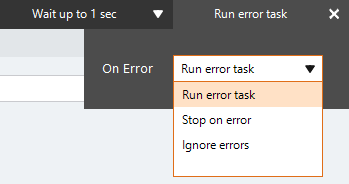Open List
The Open List action An instruction within a botflow. imports data from a file into a list in a botflow Automated steps that you can design for each bot that will run..
The Open List action works similar to the Open Data action and supports the same file types for import.
Using the Open List action, you can open a list to:
- Cross reference information from several different databases.
- Prepare to consolidate information from several different sources.
Some examples of using the Open List action with lists are:
- A list created in the Nintex Bot Botflow pane.
-
With a Loop Action to perform a work action with each item in the list.
Add an Open List action to a botflow
This example provides the steps necessary to add an Open List action to a botflow.
To add an Open List action to a botflow:
- On the Actions List, click Lists and then click Open List from the List list.
The Action Builder window for Open List displays.
- Set the Open List settings:
- File: Enter a file name in the File field.
- List: Enter a name in the List field.
- Overwrite: Check the box to overwrite a list with the same name.
- Import: Click to start the Data Source Data Wizard.
The Import option displays.
- If needed, adjust the Run Error Task settings to fine tune how the action runs.
- If needed, adjust the Run Switch setting to create the action without running it.
- Optionally, add an action note.
- Click OK to add the Open List action to the botflow.
| Field or button | Description |
|---|---|
| Open List Options/Settings | General
Options
|
| Run error task |
|
| Note |
(Optional) Type a Note to document any special instructions or functionality.
|
| Run Switch |
The Run Switch toggle controls how Nintex Bot runs an action when adding or editing an action in a botflow.
|
| OK/Cancel | Click OK to save the action or click Cancel to discard the action or any changes. |



